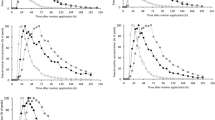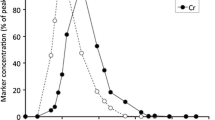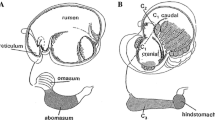Abstract
Five mouflon [average body mass (BM) 33 kg] and two roe deer (average BM 20 kg) with rumen cannulas were kept in large enclosures under semi-natural conditions and were used for seasonal studies on gastrointestinal tract (GIT) indigestible fill and digesta passage kinetics. As the mouflon were not fully mature, both species had similar digesta volumes in the reticulorumen (RR; mouflon 5.5 ± 1.8% of BM; roe deer 5.4 ± 1.5% of BM); however, the mouflon had lower RR liquid flow rates (15.1 ± 4.3 ml h−1 kg−0.75) than the roe deer (19.2 ± 0.2 ml h−1 kg−0.75), and particle retention in the RR accounted for 68 ± 3% of total GIT retention in the mouflon versus 55 ± 6% in the roe deer. Annual average total GIT retention times for liquids and particles were longer in the mouflon (23.4 ± 0.9 h and 37.9 ± 4.0 h) than in the roe deer (18.4 ± 1.7 h and 22.4 ± 1.9 h). Similarly, annual average RR retention times for liquids and particles were longer in the mouflon (11.9 ± 0.9 h and 25.8 ± 3.3 h) than in the roe deer (8.1 ± 1.7 h and 12.5 ± 2.3 h). The factor of selective particle retention in the RR (retention of particles/retention of liquid) was 2.10 ± 0.09 in the mouflon versus 1.54 ± 0.01 in the roe deer. These observations are in accord with differences in digesta passage characteristics postulated between browsing and grazing ruminants. Total GIT indigestible fill was lower in the mouflon than in the roe deer (10.7 ± 2.1 g kg−1 and 13.3 ± 1.0 g kg−1).
Similar content being viewed by others
References
Brüggemann J., Giesecke D. and Walser-Käst K. 1967. Beiträge zur Wildbiologie und vergleichenden Tierphysiologie. II. Mikroorganismen im Pansen von Rothirsch (Cervus elaphus) und Reh (Capreolus capreolus). Zeitschrift für Tierphysiologie, Tierernährung und Futtermittelkunde 23: 143–151.
Buisson J. 1923. Les infusoires ciliés du tube digestive de l’homme et des mammifičres. Amedee Legrand, Paris: 1–200.
Clauss M., Lechner-Doll M., Behrend A., Lason K., Lang D. and Streich W. J. 2001. Particle retention in the forestomach of a browsing ruminant, the roe deerCapreolus capreolus. Acta Theriologica 46: 103–107.
Clauss M., Lechner-Doll M. and Streich W. J. 2003. Ruminant diversification as an adaptation to the physicomechanical characteristics of forage. A reevaluation of an old debate and a new hypothesis. Oikos 102: 253–262.
Cornelis J., Casaer J. and Hermy M. 1999. Impact of season, habitat and research techniques on diet composition of roe deer (Capreolus capreolus): a review. Journal of Zoology, London 248: 195–207.
Dehority B. A. 1986. Microbes in the foregut of arctic ruminants. [In: Control of digestion and metabolism in ruminants. L. P. Milligan, W. L. Grovum and A. Dobson, eds]. Reston Book, Prentice Hall, Englewoods Cliff, N. J.: 307–325.
Deutsch A., Lechner-Doll M. and Wolf G. A. A. 1998. Activity of cellulolytic enzymes in the contents of reticulorumen and caecocolon of roe deer (Capreolus capreolus). Comparative Biochemistry and Physiology 119 A: 925–930.
Drescher-Kaaden U. 1976. Tests on the digestive system of roe deer, fallow deer and mouflon. Report 1: Weight statistics and capacity measurements on the digestive system, particularly of the rumenreticulum of roe deer, fallow deer and mouflon. Zeitschrift für Jagdwissenschaften 22: 184–190.
Drescher-Kaden U. and Seifelnasr E. A. 1977. Experiments on the digestive tract of roe deer, fallow deer and mouflon. Report 3: Microorganisms in the rumen of roe deer, fallow deer and mouflon. Zeitschrift für Jagdwissenschaften 23: 64–69.
Dróżdż A. and Osiecki A. 1973. Intake and digestibility of natural feeds by roe deer. Acta Theriologica 18: 81–91.
Gasaway W. and Coady J. W. 1974. Review of energy requirements and rumen fermentation in moose and other ruminants. Naturaliste Canadien 101: 227–262.
Geiger G., Hofmann R. and König R. 1977. Vergleichend-anatomische Untersuchungen an den Vormägen von Damwild (Cervus dama) und Muffelwild (Ovis ammon musimon). Säugetierkundliche Mitteilungen 25: 7–21.
Gill J. 1960. Der Grössenvergleich des Mgendarmkanals des MufflonsOvis musimon (Pallas 1811) und des MähnenschafsAmmotragus lervia (Pallas 1777). Acta Theriologica 4: 93–101.
Gordon I. J. and llius A. W. 1994. The functional significance of the browser-grazer dichotomy in African ruminants. Oecologia 98: 167–175.
Grovum W. L. and Williams V. J. 1973. Rate of passage of digesta in sheep. IV. Passage of marker through the alimentary tract and the biological relevance of rate-constants derived from changes in concentration of marker in faeces. British Journal of Nutrition 30: 313–329.
Hadjisterkotis E. 1996. Food habits of the Cyprus mouflonOvis gmelini ophion. Zeitschrift für Jagdwissenschaften 42: 256–263.
Hofmann R. R. 1973. The ruminant stomach. East African Monographs in Biology, Vol II, East African Literature Bureau, Nairobi, Kenia: 1-354. Hofmann R. R. 1988. Morphophysiological evolutionary adaptations of the ruminant digestive system. [In: Aspects of digestive physiology in ruminants. A. Dobson and M. J. Dobson, eds]. Cornell University Press, Ithaca, NY: 1–19.
Hofmann R. R. 1989. Evolutionary steps of ecophysiological adaptation and diversification of ruminants: a comparative view of their digestive system. Oecologia 78: 443–457.
Hofmann R. R., Geiger G. and König R. 1976. Vergleichend-anatomische Untersuchungen an der Vormagenschleimhaut von Rehwild und Rotwild. Zeitschrift für Säugetierkunde 41: 167–193.
Holand O. 1992. Winter digestive strategy of a concentrate selector in Norway: the European roe deer (Capreolus capreolus). Canadian Journal of Zoology 70: 1331–1335.
Holand O. 1994. Seasonal dynamics of digestion in relation to diet quality and intake in European roe deer (Capreolus capreolus). Oecologia 98: 274–279.
Holleman D. F. and White R. G. 1989. Determination of digesta fill and passage rate from nonabsorbed particulate phase markers using the single dosing method. Canadian Journal of Zoology 67: 488–494.
Hudson R. J. and White R. G. 1985. Bioenergetics of wild herbivores. CRC Press, Boca Raton, FL: 1–314.
Iason G. R. and Van Wieren S. E. 1999. Adaptations of mammalian herbivores to low quality forage. [In: Herbivores, plants and predators. H. Olff, V. K. Brown and R. H. Drent, eds]. Blackwell Science, Oxford: 337–369.
Illius A. W. and Gordon I. J. 1992. Modelling the nutritional ecology of ungulate herbivores: evolution of body size and competitive interactions. Oecologia 89: 428–434.
Kamler J. 2001. Morphological variability of forestomach mucosal membrane in red deer, fallow deer, roe deer and mouflon. Small Ruminant Research 41: 101–107.
Kay R. N. B. 1987. Comparative studies of food propulsion in ruminants. [In: Physiological and pharmacological aspects of the reticulo-rumen. L. A. A. Ooms, A. D. Degtyse and A. S. J. Van Miert, eds]. Marinus Nijhoff, Boston: 155–170.
Lechner-Doll M. and von Engelhardt W. 1989. Particle size and passage from the forestomach in camels compared to cattle and sheep fed a similar diet. Journal of Animal Physiology and Animal Nutrition 61: 120–128.
Lechner-Doll M., Rutagwenda T., Schwartz H. J., Schultka W. and von Engelhardt W. 1990. Seasonal changes of ingesta mean retention time and forestomach fluid volume in indigenous camels, cattle, sheep and goats grazing a thornbush savannah pasture in Kenya. Journal of Agricultural Science, Cambridge 115: 409–420.
Lechner-Doll M., Kaske M. and von Engelhardt W. 1991. Factors affecting the mean retention time of particles in the forestomach of ruminants and camelids. [In: Physiological aspects of digestion and metabolism in ruminants. T. Tsuda, Y. Saaski and R. Kawashima, eds]. Academic Press, San Diego, CA: 455–482.
Meyer H. H. D., Rowell A., Streich W. J., Stoffel B. and Hofmann R. R. 1998. Accumulation of polyunsaturated fatty acids by concentrate selecting ruminants. Comparative Biochemistry and Physiology 120 A: 263–268.
Mottl S. 1960. [Muflon. Biology and breeding]. Statne Zemedelske Nakladatelstvi, Prague: 1–179. [In Czech]
Offer N. W. and Dixon J. 2000. Factors affecting outflow rate from the reticulo-rumen. Nutrition Abstracts and Reviews Series B: Livestock Feeds and Feeding 70: 833–844.
Onderscheka K. and Jordan H. 1976. Einfluss der Jahreszeit, des Biotops und der Äsungskonkurrenz auf die botanische Zusammensetzung des Panseninhaltes beim Gams-, Reh-, Muffel- und Rotwild. Die Bodenkultur (Wien) 27: 202–217.
Owen-Smith N. 1992. Grazers and browsers: ecological and social contrasts among African ruminants. [In: “Ongulés 91”: Proceedings of the International Symposium “Ongulés/ Ungulates 91”, Toulouse, France, September 2–6. F. Spitz, ed]. Société Française pour l’Etude et la Protection des Mammifčres, Paris: 175–181.
Prins R. A. and Kreulen D. A. 1991. Comparative aspects of plant cell wall digestion in mammals. [In: The rumen ecosystem: the microbial metabolism and its regulation. S. Hoshino, R. Onodera, H. Minoto and H. Itabashi, eds]. Japan Scientific Soc. Press, Tokyo: 109–121.
Prins R. A., Lankhorst A. and Van Hoven W. 1984. Gastrointestinal fermentation in herbivores and the extent of plant cell-wall digestion. [In: Herbivore nutrition in the subtropics and tropics. F. M. C. Gilchrist and R. I. Mackie, eds]. Science Press, Craighall, South Africa: 403–434.
Robbins C. T. 1993. Wildlife feeding and nutrition. 2nd ed. Academic Press, San Diego: 1–352.
Robbins C. T., Spalinger D. E. and Van Hoven W. 1995. Adaptation of ruminants to browse and grass diets: are anatomical-based browser-grazer interpretations valid? Oecologia 103: 208–213.
Rowell-Schäfer A., Dyer J., Hofmann R. R., Lechner-Doll M., Meyer H. H. D., Shirazi-Beechey S. P. and Streich W. J. 1999. Abundance of intestinal Na+/glucose cotransporter in roe deer. Journal of Animal Physiology and Animal Nutrition 82: 25–32.
Rowell-Schäfer A., Lechner-Doll M., Hofmann R. R., Streich W. J., Güven B. and Meyer H. H. D. 2001. Metabolic evidence of a ‘rumen bypass’ or a ‘ruminal escape’ of nutrients in roe deer. Comparative Biochemistry and Physiology 128 A: 289–298.
Stubbe I. 1966. Growth and body size of the European roe deer. Der Zoologische Garten N. F. 33: 85–105.
Stubbe I. 1977. Body dimensions and weight development of mouflon in the Harz Mountains. Beiträge zur Jagd- und Wildforschung 10: 113–120.
Sutherland T. 1988. Particle separation in the forestomach of sheep. [In: Aspects of digestive physiology in ruminants. A. Dobson and M. J. Dobson, eds]. Cornell University Press, Ithaca: 43–73.
Thielemans M. F., Francois E., Bodart C. and Thewis A. 1978. Mesure du transit gastrointestinal chez le porc à l’aide des radiolanthanides. Comparaisons avec le mouton. Annales de Biologie des Animaux, Biochémie et Biophysique 18: 237–247.
Tuercke F. and Schmincke S. 1965. Das Muffelwild. Paul Parey, Berlin: 1–193.
Udén P., Colucci P. E. and Van Soest P. J. 1980. Investigation of chromium, cerium and cobalt as markers in digesta. Rate of passage studies. Journal of the Science of Food and Agriculture 31: 625–632.
Van Wieren S. E. 1996. A comparison of voluntary food intake, digestive capacity and the rate of passage of fibrous feeds in roe deer, red deer, highland cattle and shetland ponies. [In: Digestive strategies in ruminants and nonruminants]. PhD thesis, Wageningen Agricultural University, Wageningen: 1–191.
Welz B. and Sperling M. 1997. Atomabsorptionsspektrometrie. 4th ed. Wiley, Weinheim: 1–700.
Author information
Authors and Affiliations
Corresponding author
Additional information
Editors were Zdzisław Pucek and Andrzej Zalewski.
Rights and permissions
About this article
Cite this article
Behrend, A., Lechner-Doll, M., Streich, W.J. et al. Seasonal faecal excretion, gut fill, liquid and particle marker retention in mouflonOvis ammon musimon, and a comparison with roe deerCapreolus capreolus . Acta Theriol 49, 503–515 (2004). https://doi.org/10.1007/BF03192594
Received:
Accepted:
Issue Date:
DOI: https://doi.org/10.1007/BF03192594




